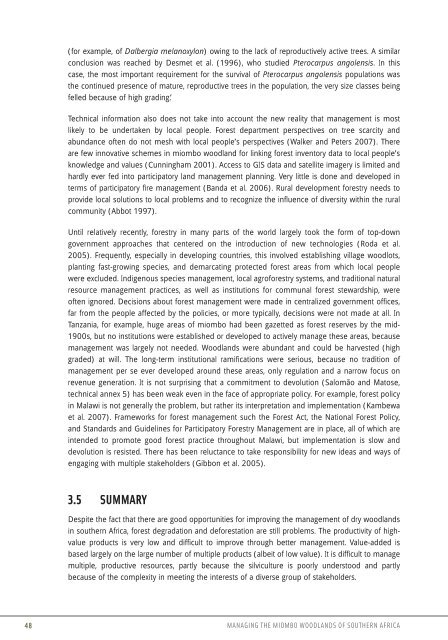Managing the Miombo Woodlands of Southern Africa - PROFOR
Managing the Miombo Woodlands of Southern Africa - PROFOR
Managing the Miombo Woodlands of Southern Africa - PROFOR
You also want an ePaper? Increase the reach of your titles
YUMPU automatically turns print PDFs into web optimized ePapers that Google loves.
(for example, <strong>of</strong> Dalbergia melanoxylon) owing to <strong>the</strong> lack <strong>of</strong> reproductively active trees. A similar<br />
conclusion was reached by Desmet et al. (1996), who studied Pterocarpus angolensis. In this<br />
case, <strong>the</strong> most important requirement for <strong>the</strong> survival <strong>of</strong> Pterocarpus angolensis populations was<br />
<strong>the</strong> continued presence <strong>of</strong> mature, reproductive trees in <strong>the</strong> population, <strong>the</strong> very size classes being<br />
felled because <strong>of</strong> high grading.’<br />
Technical information also does not take into account <strong>the</strong> new reality that management is most<br />
likely to be undertaken by local people. Forest department perspectives on tree scarcity and<br />
abundance <strong>of</strong>ten do not mesh with local people’s perspectives (Walker and Peters 2007). There<br />
are few innovative schemes in miombo woodland for linking forest inventory data to local people’s<br />
knowledge and values (Cunningham 2001). Access to GIS data and satellite imagery is limited and<br />
hardly ever fed into participatory land management planning. Very little is done and developed in<br />
terms <strong>of</strong> participatory fi re management (Banda et al. 2006). Rural development forestry needs to<br />
provide local solutions to local problems and to recognize <strong>the</strong> infl uence <strong>of</strong> diversity within <strong>the</strong> rural<br />
community (Abbot 1997).<br />
Until relatively recently, forestry in many parts <strong>of</strong> <strong>the</strong> world largely took <strong>the</strong> form <strong>of</strong> top-down<br />
government approaches that centered on <strong>the</strong> introduction <strong>of</strong> new technologies (Roda et al.<br />
2005). Frequently, especially in developing countries, this involved establishing village woodlots,<br />
planting fast-growing species, and demarcating protected forest areas from which local people<br />
were excluded. Indigenous species management, local agr<strong>of</strong>orestry systems, and traditional natural<br />
resource management practices, as well as institutions for communal forest stewardship, were<br />
<strong>of</strong>ten ignored. Decisions about forest management were made in centralized government <strong>of</strong>fi ces,<br />
far from <strong>the</strong> people affected by <strong>the</strong> policies, or more typically, decisions were not made at all. In<br />
Tanzania, for example, huge areas <strong>of</strong> miombo had been gazetted as forest reserves by <strong>the</strong> mid-<br />
1900s, but no institutions were established or developed to actively manage <strong>the</strong>se areas, because<br />
management was largely not needed. <strong>Woodlands</strong> were abundant and could be harvested (high<br />
graded) at will. The long-term institutional ramifi cations were serious, because no tradition <strong>of</strong><br />
management per se ever developed around <strong>the</strong>se areas, only regulation and a narrow focus on<br />
revenue generation. It is not surprising that a commitment to devolution (Salomão and Matose,<br />
technical annex 5) has been weak even in <strong>the</strong> face <strong>of</strong> appropriate policy. For example, forest policy<br />
in Malawi is not generally <strong>the</strong> problem, but ra<strong>the</strong>r its interpretation and implementation (Kambewa<br />
et al. 2007). Frameworks for forest management such <strong>the</strong> Forest Act, <strong>the</strong> National Forest Policy,<br />
and Standards and Guidelines for Participatory Forestry Management are in place, all <strong>of</strong> which are<br />
intended to promote good forest practice throughout Malawi, but implementation is slow and<br />
devolution is resisted. There has been reluctance to take responsibility for new ideas and ways <strong>of</strong><br />
engaging with multiple stakeholders (Gibbon et al. 2005).<br />
3.5 SUMMARY<br />
Despite <strong>the</strong> fact that <strong>the</strong>re are good opportunities for improving <strong>the</strong> management <strong>of</strong> dry woodlands<br />
in sou<strong>the</strong>rn <strong>Africa</strong>, forest degradation and deforestation are still problems. The productivity <strong>of</strong> highvalue<br />
products is very low and diffi cult to improve through better management. Value-added is<br />
based largely on <strong>the</strong> large number <strong>of</strong> multiple products (albeit <strong>of</strong> low value). It is diffi cult to manage<br />
multiple, productive resources, partly because <strong>the</strong> silviculture is poorly understood and partly<br />
because <strong>of</strong> <strong>the</strong> complexity in meeting <strong>the</strong> interests <strong>of</strong> a diverse group <strong>of</strong> stakeholders.<br />
48 MANAGING THE MIOMBO WOODLANDS OF SOUTHERN AFRICA

















